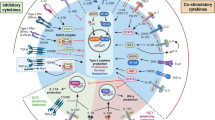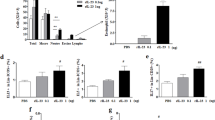Abstract
ILC2s are implicated in asthma pathogenesis, but little is known about the mechanisms underlying their accumulation in airways. We investigated the time course of ILC2 accumulation in different tissues in murine models of asthma induced by a serial per-nasal challenge with ovalbumin (OVA), house dust mice (HDM), IL-25 and IL-33 and explored the potential roles of ILC2-attracting chemokines in this phenomenon. Flow cytometry was used to enumerate ILC2s at various time points. The effects of cytokines and chemokines on ILC2 migration were measured in vitro using a chemotaxis assay and in vivo using small animal imaging. Compared with saline and OVA challenge, both IL-25 and IL-33 challenge alone induced significant accumulation of ILC2s in the mediastinal lymph nodes, lung tissue and bronchoalveolar lavage fluid of challenged animals, but with a distinct potency and kinetics. In vitro, IL-33 and CXCL16, but not IL-25 or CCL25, directly induced ILC2 migration. Small animal in vivo imaging further confirmed that a single intranasal provocation with IL-33 or CXCL16 was sufficient to induce the accumulation of ILC2s in the lungs following injection via the tail vein. Moreover, IL-33-induced ILC2 migration involved the activation of ERK1/2, p38, Akt, JNK and NF-κB, while CXCL16-induced ILC2 migration involved the activation of ERK1/2, p38 and Akt. These data support the hypothesis that epithelium-derived IL-25 and IL-33 induce lung accumulation of ILC2s, while IL-33 exerts a direct chemotactic effect in this process. Although ILC2s express the chemokine receptors CXCR6 and CCR9, only CXCL16, the ligand of CXCR6, exhibits a direct chemoattractant effect.
This is a preview of subscription content, access via your institution
Access options
Subscribe to this journal
Receive 12 digital issues and online access to articles
$119.00 per year
only $9.92 per issue
Buy this article
- Purchase on Springer Link
- Instant access to full article PDF
Prices may be subject to local taxes which are calculated during checkout










Similar content being viewed by others
References
Spits, H. et al. Innate lymphoid cells--a proposal for uniform nomenclature. Nat. Rev. Immunol. 13, 145–149 (2013).
Klose, C. S. et al. Differentiation of type 1 ILCs from a common progenitor to all helper-like innate lymphoid cell lineages. Cell 157, 340–356 (2014).
Spits, H. & Di Santo, J. P. The expanding family of innate lymphoid cells: regulators and effectors of immunity and tissue remodeling. Nat. Immunol. 12, 21–27 (2011).
Walker, J. A. & McKenzie, A. N. Development and function of group 2 innate lymphoid cells. Curr. Opin. Immunol. 25, 148–155 (2013).
Barlow, J. L. & McKenzie, A. N. Type-2 innate lymphoid cells in human allergic disease. Curr. Opin. Allergy Clin. Immunol. 14, 397–403 (2014).
Lund, S., Walford, H. H. & Doherty, T. A. Type 2 Innate Lymphoid Cells in Allergic Disease. Curr. Immunol. Rev. 9, 214–221 (2013).
Monticelli, L. et al. Innate lymphoid cells promote lung-tissue homeostasis after infection with influenza virus. Nat. Immunol. 12, 1045–1054 (2011).
Mjosberg, J. M. et al. Human IL-25- and IL-33-responsive type 2 innate lymphoid cells are defined by expression of CRTH2 and CD161. Nat. Immunol. 12, 1055–1062 (2011).
Allakhverdi, Z. et al. CD34 + hemopoietic progenitor cells are potent effectors of allergic inflammation. J. Allergy Clin. Immunol. 123, 472–478 (2009).
Chang, Y. J. et al. Innate lymphoid cells mediate influenza-induced airway hyper-reactivity independently of adaptive immunity. Nat. Immunol. 12, 631–638 (2011).
Kim, H. K. et al. Innate type 2 response to Alternaria extract enhances ryegrass-induced lung inflammation. Int. Arch. Allergy Immunol. 163, 92–105 (2014).
Wilhelm, C. et al. An IL-9 fate reporter demonstrates the induction of an innate IL-9 response in lung inflammation. Nat. Immunol. 12, 1071–1077 (2011).
Barlow, J. L. et al. Innate IL-13-producing nuocytes arise during allergic lung inflammation and contribute to airways hyperreactivity. J. Allergy Clin. Immunol. 129, 191–198 (2012).
Barlow, J. L. et al. IL-33 is more potent than IL-25 in provoking IL-13-producing nuocytes (type 2 innate lymphoid cells) and airway contraction. J. Allergy Clin. Immunol. 132, 933–941 (2013).
Klose, C. S. & Artis, D. Innate lymphoid cells as regulators of immunity, inflammation and tissue homeostasis. Nat. Immunol. 17, 765–774 (2016).
Hoyler, T. et al. The transcription factor GATA-3 controls cell fate and maintenance of type 2 innate lymphoid cells. Immunity 37, 634–648 (2012).
Yao, X. J. et al. Direct comparison of the dynamics of IL-25- and ‘allergen’-induced airways inflammation, remodelling and hypersensitivity in a murine asthma model. Clin. Exp. Allergy 44, 765–777 (2014).
Li, Y. et al. Distinct sustained structural and functional effects of interleukin-33 and interleukin-25 on the airways in a murine asthma surrogate. Immunology 145, 508–518 (2015).
Neill, D. R. et al. Nuocytes represent a new innate effector leukocyte that mediates type-2 immunity. Nature 464, 1367–1370 (2010).
Drake, L. Y., Iijima, K. & Kita, H. Group 2 innate lymphoid cells and CD4 + T cells cooperate to mediate type 2 immune response in mice. Allergy 69, 1300–1307 (2014).
Diegelmann, J. et al. Expression and regulation of the chemokine CXCL16 in Crohn’s disease and models of intestinal inflammation. Inflamm. Bowel Dis. 16, 1871–1881 (2010).
Marques, P. et al. Cigarette smoke increases endothelial CXCL16-leukocyte CXCR6 adhesion in Vitro and in vivo. Potential consequences in chronic obstructive pulmonary disease. Front. Immunol. 13, 1766 (2017).
Grotenboer, N. S., Ketelaar, M. E., Koppelman, G. H. & Nawijn, M. C. Decoding asthma: translating genetic variation in IL33 and IL1RL1 into disease pathophysiology. J. Allergy Clin. Immunol. 131, 856–865 (2013).
Sun, B. et al. Characterization and allergic role of IL-33-induced neutrophil polarization. Cell Mol. Immunol. 15,782–793 (2018).
Kwon, K. H., Ohigashi, H. & Murakami, A. Dextran sulfate sodium enhances interleukin-1 beta release via activation of p38 MAPK and ERK1/2 pathways in murine peritoneal macrophages. Life. Sci. 81, 362–371 (2007).
Yu, X. et al. CXCL16 induces angiogenesis in autocrine signaling pathway involving hypoxia-inducible factor 1alpha in human umbilical vein endothelial cells. Oncol. Rep. 35, 1557–1565 (2016).
Wehr, A. et al. Pharmacological inhibition of the chemokine CXCL16 diminishes liver macrophage infiltration and steatohepatitis in chronic hepatic injury. PLoS One 9, e112327 (2014).
Riesenfeld, E. et al. The Temporal Evolution of Airways Hyperresponsiveness and Inflammation. J. Allergy Ther. 1, 1–7 (2012).
Li, B. W. et al. T cells are necessary for ILC2 activation in house dust mite-induced allergic airway inflammation in mice. Eur. J. Immunol. 46, 1392–1403 (2016).
Chea, S. et al. CXCR6 Expression Is Important for Retention and Circulation of ILC Precursors. Mediat. Inflamm. 2015, 368427 (2015).
Possot, C. et al. Notch signaling is necessary for adult, but not fetal, development of RORgammat( + ) innate lymphoid cells. Nat. Immunol. 12, 949–958 (2011).
Salimi, M. et al. A role for IL-25 and IL-33-driven type-2 innate lymphoid cells in atopic dermatitis. J. Exp. Med. 210, 2939–2950 (2013).
Xue, L. et al. Prostaglandin D2 activates group 2 innate lymphoid cells through chemoattractant receptor-homologous molecule expressed on TH2 cells. J. Allergy Clin. Immunol. 133, 1184–1194 (2014).
Johnston, B., Kim, C. H., Soler, D., Emoto, M. & Butcher, E. C. Differential chemokine responses and homing patterns of murine TCR alpha beta NKT cell subsets. J. Immunol. 171, 2960–2969 (2003).
Rajput, C. et al. RORα-dependent type 2 innate lymphoid cells are required and sufficient for mucous metaplasia in immature mice. Am. J. Physiol. Lung Cell. Mol. Physiol. 312, L983–L993 (2017).
Brand, S., Sakaguchi, T., Gu, X., Colgan, S. P. & Reinecker, H. C. Fractalkine-mediated signals regulate cell-survival and immune-modulatory responses in intestinal epithelial cells. Gastroenterology 122, 166–177 (2002).
Brand, S. et al. CXCR4 and CXCL12 are inversely expressed in colorectal cancer cells and modulate cancer cell migration, invasion and MMP-9 activation. Exp. Cell Res. 310, 117–130 (2005).
Brand, S. et al. Cell differentiation dependent expressed CCR6 mediates ERK-1/2, SAPK/JNK, and Akt signaling resulting in proliferation and migration of colorectal cancer cells. J. Cell. Biochem. 97, 709–723 (2006).
Tilton, B. et al. Signal transduction by CXC chemokine receptor 4. Stromal cell-derived factor 1 stimulates prolonged protein kinase B and extracellular signal-regulated kinase 2 activation in T lymphocytes. J. Exp. Med. 192, 313–324 (2000).
Acknowledgements
We acknowledge financial support from the National Natural Science Foundation of China (81373177, 81471594, and 81700026).
Author information
Authors and Affiliations
Corresponding authors
Additional information
Publisher’s note: Springer Nature remains neutral with regard to jurisdictional claims in published maps and institutional affiliations.
Rights and permissions
About this article
Cite this article
Li, Y., Chen, S., Chi, Y. et al. Kinetics of the accumulation of group 2 innate lymphoid cells in IL-33-induced and IL-25-induced murine models of asthma: a potential role for the chemokine CXCL16. Cell Mol Immunol 16, 75–86 (2019). https://doi.org/10.1038/s41423-018-0182-0
Received:
Revised:
Accepted:
Published:
Issue Date:
DOI: https://doi.org/10.1038/s41423-018-0182-0
Key words
This article is cited by
-
LSD1 drives intestinal epithelial maturation and controls small intestinal immune cell composition independent of microbiota in a murine model
Nature Communications (2024)
-
The absence of IL-9 reduces allergic airway inflammation by reducing ILC2, Th2 and mast cells in murine model of asthma
BMC Pulmonary Medicine (2022)
-
Role of specialized pro-resolving lipid mediators in pulmonary inflammation diseases: mechanisms and development
Respiratory Research (2021)
-
Factors affecting the migration of ILC2s in allergic disease
Cellular & Molecular Immunology (2021)
-
The pathogenic role of innate lymphoid cells in autoimmune-related and inflammatory skin diseases
Cellular & Molecular Immunology (2020)



